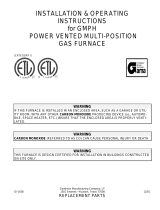
4
REQUIREMENTS & CODES
WARNING:
The information listed below must be followed
during the installation, service, and operation
of this furnace. Failure to follow safety
recommendations could result in possible
damage to the equipment, serious personal
injury or death.
• This furnace must be installed in accordance with
these instructions, all applicable local building codes
and the current revision of the National Fuel Gas Code
(NFPA54/ANSI Z223.1) or the Natural Gas and Propane
Installation Code, CAN/CGA B149.1.
• Use only with type of gas approved for this furnace.
Refer to the furnace rating plate.
• Install this furnace only in a location and position as
specified on page 5.
• Provide adequate combustion and ventilation air to the
furnace space as specified on pages 6 - 10.
• Provide adequate clearances around the vent air intake
terminal as specified in Figures 1 - 4 (pages 9 - 10).
• Combustion products must be discharged outdoors.
Connect this furnace to an approved vent system only,
as specified on pages 7 - 10.
• Never test for gas leaks with an open flame. Use
a commercially available soap solution to check all
connections. See pages 16 - 17.
• This furnace is designed to operate with a maximum
external pressure rise of 0.3 inches of water column.
Consult Table 5 (page 24) and the rating plate for the
proper circulating air flow and temperature rise. It is
important that the duct system be designed to provide
the correct flow rates and external pressure rise. An
improperly designed duct system can result in nuisance
shutdowns, and comfort or noise issues.
• This furnace must not be used for temporary heating
of buildings or structures under construction.
• The Commonwealth of Massachusetts requires
compliance with regulation 248 CMR 4.00 and 5.00 for
installation of through – the – wall vented gas appliances
as follows:
1. For direct-vent appliances, mechanical-vent heating
appliances or domestic hot water equipment, where the
bottom of the vent terminal and the air intake is installed
below four feet above grade the following requirements
must be satisfied:
a.) A carbon monoxide (CO) detector and alarm shall
be placed on each floor level where there are
bedrooms. The detector shall comply with NFPA
720 (2005 Edition) and be mounted in the living
area outside the bedroom(s).
b.) A (CO) detector shall be located in the room that
houses the appliance or equipment and shall:
• Be powered by the same electrical circuit as the
appliance or equipment. Only one service switch
shall power the appliance and the (CO) detector;
• Have battery back-up power;
• Meet ANSI/UL 2034 Standards and comply with
NFPA 720 (2005 Edition); and Approved and listed
by a Nationally Recognized Testing Laboratory as
recognized under 527 CMR.
c.) A Product-approved vent terminal must be used,
and if applicable, a product-approved air intake must
be used. Installation shall be in strict compliance
with the manufacturer’s instructions. A copy of
the installation instructions shall remain with the
appliance or equipment at the completion of the
installation.
d.) A metal or plastic identification plate shall be mounted
at the exterior of the building, 4 feet directly above
the location of vent terminal. The plate shall be of
sufficient size, easily read from a distance of eight
feet away, and read “Gas Vent Directly Below”.
2. For direct-vent appliances, mechanical vent heating
appliances or domestic hot water equipment where the
bottom of the vent terminal and the air intake is installed
above four feet above grade the following requirements
must be satisfied:
a.) A (CO) detector and alarm shall be placed on each
floor level where there are bedrooms. The detector
shall comply with NFPA 720 (2005 Edition) and be
mounted in the living area outside the bedroom(s).
b.) The (CO) detector shall:
• Be located in the room that houses the appliance
or equipment;
• Be hard-wired, battery powered or both.
• Shall comply with NFPA 720 (2005 Edition).
c.) A product-approved vent terminal must be used,
and if applicable, a product-approved air intake must
be used. Installation shall be in strict compliance
with the manufacturer’s instructions. A copy of
the installation instructions shall remain with the
appliance or equipment at the completion of the
installation.
Clearances to Combustible Materials
This furnace is Design Certified in the U.S. and Canada
by CSA International for the minimum clearances to
combustible materials. NOTE: The furnace is listed for
installation on combustible or non-combustible flooring.
However, wood is the only combustible flooring allowed
for installation. To obtain furnace base model number and
specific clearance information, refer to the furnace rating
plate, located inside of the furnace cabinet.
Access for positioning and servicing the unit must be
considered when locating unit. The need to provide
clearance for access to panels or doors may require
clearance distances over and above the requirements.
Allow 18 inches minimum clearance from the front of
the unit. However 36 inches is strongly recommended.
See Table 1 for minimum clearance requirements.
The ductwork should be appropriately sized to the capacity
of the furnace to ensure its proper airflow rating. For
installations above 2,000 ft., the furnace should have a
sea level input rating large enough that it will meet the
heating load after deration for altitude.




















